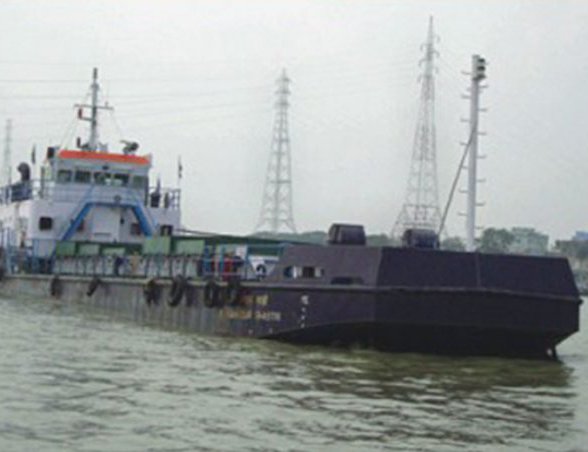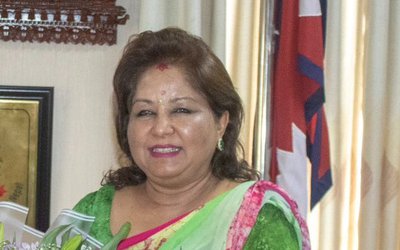
Just two days before the opening of the Ship Department by Prime Minister KP Sharma Oli, who has been harping on a slogan to bring ship to Nepal from Bay of Bengal, the opening of construction of the Gandak Waterways has rejuvenated the Nepali authorities and people.
Although it is technically a long way to go before starting the operation of ship between Nepal and India in the Ganga river, Nepal’s authorities and experts have started to think about the use of waterways.
Unlike Prime Minister Oli's statement, so many technical issues need to be addressed before the operation of waterways, which is regarded as one of the cheapest means of transport to carry goods from one place to another.
However, making the river transport possible in Gandak, Kosi and Karnali is a highly technical issue. There is the need to maintain a certain level of water in the rivers to make river ways possible.
For this Nepal needs to make dams and high dams on its side. Experts argue that there is the need to make a give and take for this. If India agrees to bear all the cost of the construction of high dam in Nepal and free access to road, Nepal has nothing to lose.
Water resource expert Dipak Gyawali argues, in his recent interviews, that Nepal will get tremendous economic advantages if the water way is developed. He said that before taking any decision on use of water ways, Nepal needs to thoroughly analyze the costs and benefits factor.
"The benefit to the seven Indian states downstream of building storage dams in Nepal is so high that Nepal's rightful shares of those overall benefits should mean that Nepal will not have to make significant investments on its own," said Gyawali.
As India's Union minister Nitin Gadkari, who holds the road transport and highways, and shipping, water resources, river development and Ganga rejuvenation portfolios laid the foundation stone for a 300 km national waterway from Balmiki Nagar in Bagaha to the confluence of river Gandak and Ganga in Hajipur, it is coming closer to see Nepal linking to India's national water ways.
Development of National Waterway -37 (river Gandak) from its confluence with river Ganga at Hajipur to Triveni Ghat (Bhaisalotan Barrage, Valmikinagar) will be the first of its kind to link Nepal to Bay of Bengal through Ganga water ways.
India is building this 300-km stretch of river Gandak at a cost of Rs 12. 91 crore. River conservancy measures and fairway development works are in progress. A floating terminal is being built at Kailashnagar near Bagaha. Additional floating pontoon facility is proposed at Dumaria Ghat.
The Hindustan Times reports that the first phase of the waterway project is scheduled to be completed by 2020. With its completion, it will be possible for vessels up to 1,000 tonnes to move on river Gandak. “There is a potential to transport 11.60 million tonnes of agricultural produce, construction material and other items over Ganga and Gandak in the next five years. Roll-on, roll-off services will save travel time. This will also open up river connectivity with Nepal and boost tourism and pilgrimage in these areas,” said Minister Gadkari.
Madahv Belbase, Joint secretary of Water and Energy Commission, who has been taking part in the bilateral meeting of river navigation, has already signed MoU with his Indian counterpart to explore the possible water ways.
"The government has been doing its homework for long. We have made several rounds of inter-ministerial meeting on this. Opening water ways is a great opportunity for us," said Belbase.
In this discussion on the inland navigation issue, Madhav Belbase described aptly Nepali understanding and stand. "If India is already going to bring it to Bagaha near our border on the Gandak, we might as well take advantage of it," said Belbase.
Nepal has been asking for use of waterways through Ganga river for long. However, no one listened to Nepal's requests. For the first time in 1997, a Nepali team led by then executive secretary of Water and Energy Commission persuaded the Indian side to agree on the use of Kosi water ways.
Waterways are the cheapest means of transport. For instance, one horse power truck can carry 150 kilogram weight. The rail carries 500 kilogram in same weight. In terms of use of energy, railway is three times cheaper than the road. However, a vessel of same category can carry 4000 kilogram of goods.
This means vessel can carry 27 times higher products than truck and eight times higher than railways. However, there are sections of people in Nepal who consider that the agreement on waterways pushed Nepal to agree to build high dams in Nepal to regulate water.
Dr. Surya Raj Acharya tweeted that water ways agenda is not in the interest of Nepal's transport sector. However, it is risky to agree water ways on the condition of high dam construction. He said that water crisis is deepening in India. For the management of high dams, including the use of water resources and management, Nepal and India need to build understanding on the distribution of costs and benefits."
However, studies have shown that the waterways are one of the cheapest ways of transportation compared to roads and railways. All the rich countries of Europe are taking benefit of water ways. Recently, China has also been using the waterways to link its remote areas to the seas.
In 2018, India and Nepal agreed to pick up the agenda agreed in 1997. After Nepal-India understanding to develop the waterways, Ministry of Industry, Commerce and Supply has already set up a team under joint secretary Madhu Marashini to look into the issues. At a time when India has pushed the agenda as a priority, the time has come for Nepal to make efforts.
Although there is no dearth of people like Acharya in Nepal who view the positive gesture critically, making negotiations and agreement with India for the broader economic development, prosperity and building new understanding will be in favor of Nepal. This is a great opportunity coming closer to Nepal.
Given India's pace of working to build waterways in Ganga, Nepal does not have to wait for a long time to reach Bay of Bengal through Ganga. For this, Nepal has to start meaningful negotiations based on reality of Nepal rather on the basis of sentiment.

Keshab Poudel
Poudel is the editor of New Spotlight Magazine.
- HELVETAS NEPAL’S RIVERBED FARMING: Shift From Overseas To Local Farming
- Jul 26, 2024
- POLITICAL SCENARIO : K.P. Sharma Oli's Resurgence
- Jul 21, 2024
- UNDP/MinErgy: An Inventive Approach To Clean Brick Kiln
- Jul 19, 2024
- HELVETAS NEPAL: Nutrition Through Riverbed Farming
- Jul 18, 2024
- NOU Opens To All: Dr. Shilu Manandhar Bajracharya, Vice Chancellor
- Jul 15, 2024
















